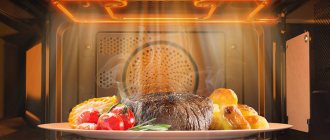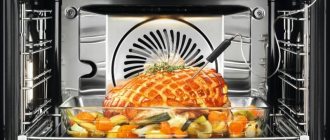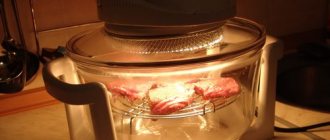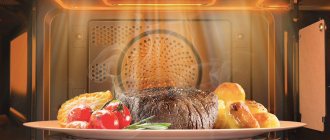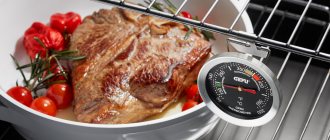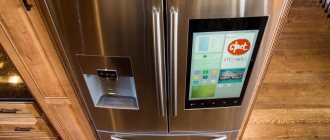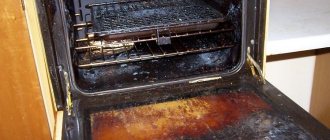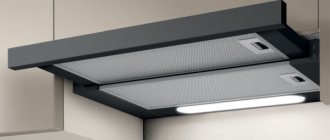Modern household appliances for the kitchen can perform a huge number of functions. Unfortunately, some of them, after purchasing a “sophisticated” oven or electric stove, remain unclaimed, but at the same time significantly increase the cost of the purchase. According to many, when buying a new oven, you should pay attention to the presence of a useful and even necessary operating mode - convection. Let's talk about what it is - convection in the oven, and why it is needed.
How the oven works
If your kitchen has a regular old model gas stove, then in its oven everything is arranged in such a way that it couldn’t be simpler: there are one or two burners located below, above which you can install shelves with baking sheets at different heights.
Heating occurs only from below, the upper part of the baked product is browned only in natural convection mode. By the term we mean the movement of heated air masses, accompanied by heat exchange.
In such an oven, this very often happens: on the one hand, on the far wall, the pies or roast have already begun to brown and burn, and the part located closer to the door has not even browned yet. You have to take out a baking sheet or pan and turn it over to even out the heat.
But not all types of tests can withstand such manipulations without consequences. For example, your sponge cake may well fall off. There is no need to talk about capricious meringues - baking meringues requires a very gentle regime so that the delicate protein foam does not settle.
A more modern gas stove may also have a top burner in the oven. Sometimes the top heating element may be electric and the bottom burner may be gas. Having an additional heat source greatly simplifies the cooking process. You can adjust the heat in the oven from above and below if necessary.
Even not the latest models of electric ovens have more than one heating element. But their presence does not ensure high-quality, uniform baking of the prepared products.
This happens because natural convection in a household oven occurs slowly and depends on other factors. For example, on the width of the baking tray placed. So if there are no gaps left on the sides, heated air from the bottom of the oven simply will not get into its upper part. In this case, the lower surface of the dough is doomed to burn, and the upper surface will remain unbaked.
And then a forced mode comes to the rescue - the convection mode. This is exactly the function that home appliance sellers praise so much when they offer you to buy an electric oven .
Electric
There is a generally accepted opinion that electric ovens bake better than gas ovens. This is true. This can be explained simply by the difference in design. In gas models, there is only one heat source - a burner located at the bottom of the chamber.
And in electric ones there are at least two, with one heating element heating from above, and the other from below, thereby ensuring uniform baking of the product. However, if you put two pies at once on different levels in such a cabinet, they will not bake equally. One will fry more strongly on top, the other on bottom, depending on which side is closer to the heating element.
Gas
As mentioned earlier, a gas cabinet only has one burner at the bottom, so even heat distribution is more difficult to achieve. First of all, they try to reduce heat loss by wrapping the chamber with insulating and reflective materials. Seal the gaps between the chamber and the door, installing 2-3 glasses in the latter.
Surely many housewives have noticed that there are holes made along the edges of the baking sheets. This is necessary so that the metal sheet does not interfere with the passage of heat, and it flows freely to the top. However, despite all these tricks, it is not always possible to achieve good baking.
This can be partly explained by the peculiarities of cooking with gas. During operation, combustion products are formed that must be removed. Therefore, in principle, the chamber in the oven cannot be sealed, and, therefore, heat loss cannot be avoided.
Convection in gas ovens
Convection ovens with gas supply are produced much less frequently than electric ones. They cost an order of magnitude higher. It is better to take such a stove from a well-known manufacturer, for example, Zanussi or Korting, since eminent companies care about their good name and, accordingly, the safety of their client. A gas oven with a convection mode must be designed so that when the fire is blown out, the gas supply is turned off to avoid poisoning. Air circulation in the gas model allows you to cook on several levels at once, which significantly saves gas and the cook’s effort.
Korting OGG 742 CRSI
What is convection in an oven
Convection is the transfer of heat by air currents. It is a Latin word that means "transfer." In simple terms, convection is when warm and cold air change places, the warm air rises and the cold air sinks.
Eventually, all layers mix and the temperature becomes the same everywhere. Perhaps someone remembers old ovens, in which the baking sheet had to be placed on the lower level first, and then raised higher so that the food did not burn from below.
So, in convection ovens there is no need to perform such manipulations. The heat will be evenly distributed immediately after heating, and the delicious pies will not burn. They will be cooked through in the middle and crispy on top, without being soggy or overcooked.
Moreover, you can put two or three baking sheets in one oven at the same time and even cook several dishes at once. Truly, this is the dream of every housewife. You save time, energy and have time to get everything done.
In older oven models, burners (gas) or heating elements (electric) were located only at the bottom, and the top of the baked goods was browned due to natural convection - the movement of heated air and heat exchange in the closed space of the oven.
The results were often disappointing: the bottom was burnt and the food was unevenly baked. I had to take out the baking sheets, turn them in different directions, and place a container of water on the bottom of the oven.
New oven models, as a rule, are also equipped with heating from above, which greatly simplifies the baking process and allows you to cook dishes on the grill. But even with combined heating (bottom and top), natural convection may not be enough for perfect baking.
The fact is that normal heat exchange in the oven occurs rather slowly; certain factors can interfere with it: a door that does not close tightly or opens it frequently, as well as large baking sheets that occupy the entire width of the oven and interfere with air circulation.
Convection (from Latin convectio - transfer) is a natural heat exchange in which internal energy is transferred by flows and jets. Warming air rises and cold air falls down.
In an oven, when layers of air are mixed more quickly due to convection, the temperature immediately becomes the same on all levels. Now any housewife can appreciate the advantages of ovens with forced convection, that is, air circulation created using a built-in fan.
It is usually located on the back wall of the oven and turns on separately when certain modes or preset programs are selected.
Various oven manufacturers offer improved convector designs that have additional features: fans with a separate heating circuit, reinforced fans to create a rapid flow of hot air, moist convection mode for steaming dishes without the use of fats.
What is forced convection
In this case, this means forced air circulation in the oven. The movement of hot air masses is provided by a fan.
In the closed space of the oven, the airflow creates a real vortex of hot air. This vortex evenly heats the product from all sides. Nothing else burns on the bottom; the top is covered with a beautiful crispy crust.
The fan is usually located on the back wall of the oven and is turned on separately.
Convector in this case means forced air circulation mode in the oven. The movement of hot air is provided by the ventilation element. In the closed space of the oven there is a real hot air blowing system.
- Convective heating while a dish is being cooked in the oven heats it up equally on all sides, therefore:
- nothing burns from the bottom;
- a magnificent fried crust forms on top;
- the dish will be completely cooked.
The forced convection system is usually located on the back wall of the oven. The fan can be turned on separately and prepare properly delicious baked dishes. After the end of cooking, the timer usually beeps, giving a signal.
Oven with convection mode
The best oven models are necessarily equipped with a convection mode. It is not found only in old products. Its presence does not have any serious impact on the cost of the electric stove. Unfortunately, not all owners of such devices know exactly why such a function is needed; they use it far from its intended purpose. But convection is created to connect different processes:
- obtaining different tastes;
- increasing the cooking speed.
Principle of operation
Convection refers to a heat transfer technique in which thermal energy is redistributed using air flow. In all electric stoves, the air is heated thanks to heating elements of different power. Hot air begins to move in the oven thanks to the installed fans. As a result, the oven maintains the same temperature. This allows the kitchen housewife to cook several different dishes on the stove at the same time.
On a note! Convection is best suited for cooking meat, fish and poultry.
Types of convection
Convection is classified according to various criteria. The complexity of the system comes first. It happens:
- simple – represented by several fans;
- complex - heating elements are equipped with built-in fans.
It is not very convenient for an ordinary user to use such a classification. The division based on the operating principle looks much clearer.
- Natural. Air mass transfer occurs. The operating principle is based on the laws of physics. Heated air rushes up, cold air goes down
- Forced. This principle is used in all modern electric stoves. Cheap products are equipped with only one fan. Expensive models have reinforced instruments. They are considered the most effective for cooking. In addition to creating powerful, uniform heating, they are capable of maintaining the required temperature for a long time.
- Wet. A new model that has not yet become widely popular. Creates fine steam in an electric oven. It improves the rise of baked goods. The food will never be dry.
Good to know! The wet type allows you to cook food without adding oil. It is simply impossible to fry the dish.
What is convection in the oven for?
It allows you to successfully bake large pieces of meat, bake wonderful pies, make delicate meringues and even simply dry herbs, delicious candied fruits or crackers. You can even skip the heat by using just cold convection. And in combination with low heat, convection will allow you to quickly defrost meat or vegetables from the freezer.
The convection mode will allow you to use the entire volume of the oven with maximum efficiency: even if you put two or three baking sheets inside, everything will bake evenly.
- It is not necessary to use this function every time you cook. It can be turned on in cases where it is really necessary:
- to ensure a crispy crust;
- to dry out too much liquid released from baked products;
- for good baking of a large pie or poultry carcass.
The modern convection oven has various baking, grilling and defrosting modes. This allows you to cook several dishes at the same time, which significantly reduces gas (electricity) consumption and the amount of cooking time.
Detailed instructions from the manufacturer tell you how to configure the necessary parameters. So, convection is a function in which forced air circulation occurs inside the oven, due to which the same heating temperature is formed on all sides.
- To understand whether convection is needed in the oven, let’s look at the advantages of this function:
- Uniform temperature. Dishes are baked on all sides at once.
- Cooking several dishes at the same time.
- Replaces hobs. In some cases, such an oven allows you not to use standard hobs (in the country, in country houses, etc.).
- Minimizing electricity and gas consumption.
- Additional modes - for baking, defrosting, drying.
- Full control and security. You can always turn off the blowing function yourself.
Advantages
Many people ask why the convection mode is needed if meat is baked perfectly in the oven without it? Why turn it on and what dishes to cook with it? This question was partially answered in the previous section.
- A convection oven has a number of advantages:
- the dish is baked evenly;
- you can cook food on several baking sheets at once;
- you can do without a hob;
- less electricity or gas consumption;
- less oil consumption;
- The range of dishes that you can cook in the oven is expanding.
In the oven, meat and fish are defrosted with a stream of hot air, medicinal and spicy herbs are dried, nuts and lemon zest are dried. The oven makes excellent meringues and various pastries made from dough. If convection is not needed, then the mode is simply not turned on.
Indeed, how many times have housewives been faced with a situation where it is necessary to cook both a side dish and meat at the same time? And when you have to bake a cake from several layers? In the latter case, cooking was delayed for several hours: first the first cake was placed, when it was baked - the second, then the third, and so on.
It was only a dream to cook several cakes at the same time on different levels. In a convection oven, you can spread the dough on several baking sheets, and it will bake equally well on all of them.
Why else should you choose a device with convection? Not everyone knows that convection can be used to dry berries and herbs. How did you usually dry it in ovens before? We laid out the food on a baking sheet, turned on the minimum heat, and opened the door.
To prevent the berries from burning, you had to stir them regularly and monitor the temperature. If you use convection in the oven, everything becomes much simpler. The fan blows the greens and berries evenly, as a result they dry quickly and do not burn.
In this case, the upper and lower heaters do not need to be turned on at all - the convector is often adjacent to an additional low-power circular heating element, which is turned on together with the fan.
In ovens, convection is often combined with other heating methods. The more expensive the model, the more functions it has, the more combinations for preparing a variety of dishes it can have.
How to tell if your oven has convection
To make it easier for customers to choose an oven in a store, special schematic images are placed on it, with the help of which the presence of certain functions is indicated. The most common icons:
- horizontal straight lines – heating elements;
- fan with three blades – convection function;
- horizontal line with teeth – grill.
Ovens offer different modes that combine these features. For example, you can turn on convection and only one heating element, or set it to grill and add a fan for more even cooking. Combined modes allow you to make more delicious dishes; the main thing is to understand which method of cooking in the oven to choose for certain products.
Types of convectors
Most often, your electric oven is provided with this opportunity by a fan of a simple design, the function of which is simply to drive air throughout the entire volume of the oven. A fan surrounded by an additional heating circuit is more efficient.
Some models of Miele electric stoves have a convenient wet convection function. When this mode is turned on, the air inside the oven is saturated with steam. Dishes don’t dry out, the dough rises better, and you can generally steam anything you want without harmful frying.
In Neff brand cabinets, manufacturers build in reinforced fans that create a rapid flow of hot air. Rapid heating gives a good effect in autumn: the product is quickly covered with a dried layer, which prevents the juices from evaporating during further baking.
All of the above applies to electric ovens. Until recently, the usual gas stove was deprived of a convenient forced mode.
But recently the Electrolux company launched a new product on the market: now a gas stove can be equipped with a fan. For now, only a free-standing gas stove can have this function, but it is not a fact that manufacturers will stop developing new models.
The fact is that a gas stove still outsells an electric one, at least when it comes to free-standing stoves. And the Russian market is no exception.
Gas in our country is still cheaper than electricity. Therefore, a gas stove is used in 80 out of 100 kitchens. Now those for whom a gas stove is more suitable will also be able to appreciate a gas oven with convection.
So, there are three popular types of stoves that are equipped with convection:
- Type 1. Gas stove + electric convection
- Several features of a gas stove with this function:
- Gas + electricity. Most often, models are produced in which the hob is powered by gas, and the oven is powered by electricity.
- Price. The cost of such a device is usually higher than one that runs entirely on electricity.
- Safety. When forced air circulation is operating, the gas supply is turned off.
- Type 2. Electric
On store shelves you can find a mini-sized electric oven. This is a fairly compact device that works when connected to the network.
An electric stove has limited space, so it can be difficult to cook several dishes inside at once.
- Type 3. Combined
Manufacturers are increasingly releasing models with mixed mode operation. This design allows you to cook with both electricity and gas.
How it works
In the oven, convection mode is possible thanks to the installation of a fan. It is the fan that moves and mixes layers of air. This mixing ensures the same temperature throughout the entire volume, as a result of which the dish is baked or fried evenly.
Most often, the fan is installed on the back wall of the oven. It circulates air, distributing heat evenly. When the desired internal temperature is reached, the fan turns off. Oven models are produced in which an additional heating circuit is installed around the fan. Due to this, the efficiency of the oven increases even more.
Electric convection ovens have dozens of functions that allow you to cook different dishes, defrost food, grill, and combine modes.
You yourself can choose the desired mode for the dish, depending on what the recipe requires and what result you want to get.
After reading the instructions, it is very easy to understand the control system. You can adjust the temperature, set the cooking time and the direction of the convection flow. Each function has its own icon.
Thus, cooking using convection with upper and lower heating turned on is indicated in the form of a stylized screw between two horizontal stripes.
Applying modes
At low temperatures (up to 150 ℃) or even without heating in convection mode, you can quickly and carefully dry fresh herbs, pieces of citrus peel, nuts, mushrooms or fruits (in particular, for uzvar - pre-peeled and cut into small flat pieces). Cold convection can also be used to defrost food.
At medium temperatures (160-220 ℃), convection provides an intense and impressive rise of products from most types of dough: yeast, sponge, shortbread, puff pastry, choux. With it you will get airy and dry inside eclairs, tender and light meringues, baked and rosy muffins.
An undoubted advantage of convection is the ability to use the entire volume of the oven to simultaneously prepare different dishes on several baking sheets.
When using the convection mode in the oven at high temperatures (from 220 ℃), large pieces of meat or poultry will retain internal juiciness, they will have a crispy crust, they will bake and fry evenly.
It is effective to use convection for drying juice if it is released in too large quantities, as well as for preparing dishes in portioned or large dishes, for example, in ceramic pots or a casserole dish.
The main differences between wet convection, enhanced and dry
- Type 1. Forced dry circulation.
The oven contains one or more fans, which may be surrounded by additional heating circuits.
- Type 2. Wet circulation.
In addition to the usual blowing, the air is saturated with moisture, thanks to which you can steam dishes.
- Type 3. Increased circulation.
A powerful fan creates a rapid flow of air, which allows the crust to set quickly and the inside of the food to remain juicy.
There should be a corresponding pictogram on the panel of both gas and electric stoves. It usually looks like a three-blade fan.
- Descriptions of other icons:
- Fan with underscore – blowing from below.
- With a zigzag on top - blowing + grill.
- Eco - wet circulation.
Convection mode in oven icon
If you bought an oven and never looked at its instructions, you can find out whether you have convection in the oven by looking at the icons and symbols on the control panel.
Depending on the oven model, the modes may vary depending on the combination of convection with the available heating options and the presence of steam.
The standard designation of convection modes includes a “fan” icon and a mark indicating the inclusion of individual heating elements (combined, selective - upper element only, lower element only, convection only).
Ovens with moist convection deserve special attention. They have built-in containers on the front or back wall, into which clean water is poured, and a steam generator.
In the humid convection mode, products are blown from all sides not just with evenly hot air, but with steam, which significantly speeds up the cooking process, helps maintain the juiciness of dishes, and reduces the amount of salt and fat. (A dream for all adherents of dietary and healthy eating!)
The most advanced models provide humidity control in several modes: hot steam (25%), intense steam (50%) and wet steam (100% - steamer mode). In this case, the moment of steam supply is automatically calculated by the program itself, but its quantity and frequency can be controlled manually.
There are options for different directions of the steam jet: distribution throughout the oven, on the dishes or on the products themselves through a special tube. Moist convection modes are convenient for sterilizing cans or baby food bottles. Convection in the oven is one of the indispensable functions of modern kitchen equipment.
It really expands your capabilities and provides enormous scope for culinary experiments. Now many traditional recipes are being revised taking into account new technological capabilities and are being adapted for convection ovens.
There is an opinion that convection in the oven allows you to reduce the temperature required for different types of baking by 10-15 ℃. Prepare your favorite dishes in a new way, come up with original recipes, make yourself and your loved ones happy!
The most useful programs
Normal convection. It is used for heating plates for the holiday, preparing (raising) dough before baking. Used for drying berries, herbs, sliced fruits and vegetables. It can also be chosen for baking juicy, minimally cooked foods suitable for dietary needs.
- A convector is useful if you need to defrost a large amount of food that will not fit in the microwave oven, for example, a Christmas turkey.
- Convector and bottom heater. This mode is used for cooking pizza, bread, pies. The main heat comes from below, baking the dough, and the hot air melts the cheese.
- Convector, bottom heater and grill. The mode is optimal for preparing frozen foods, including semi-finished products. This combination of heaters allows you not only to bake food, but also to form a golden brown crust on their surface.
- Turbo grill. In this mode, the convector, top heater and grill are turned on. Used for frying large pieces of meat, baking a crust on food.
It should be clarified that all of these modes, except the first, involve cooking at only one level. If you install several baking trays in the oven, the effectiveness of the combinations decreases.
Double convection
There are models in which two convectors are installed, located one above the other. This design is found in Samsung ovens, for example, Samsung BTS14D4T. Two fans distribute air more efficiently than one.
If in models with one convector the pies on different levels may turn out to be baked differently (on the middle tier the airflow is more intense, on the lower one less), then with two this problem will not arise. Each fan blows at its own level, so the food is baked at the same time.
It should be clarified that a convection oven should be purchased if the owner will regularly cook in this mode, since this function significantly increases the cost of the equipment.
Application of humid convection
Those who adhere to a healthy diet will be interested to know that some oven models have a moist convection mode. What is it for?
This mode allows you to steam food while preserving nutrients. Hot steam is supplied to the oven, so the food is not overcooked. It remains juicy and soft inside. The most famous brands offering such equipment are Electrolux, Miele, Smeg, Hansa.
In order for the wet convection mode to work in the oven, you need to pour water into a special container on the door or on the back wall. Once turned on, the water enters the steam generator and within a few minutes it will fill the oven.
- The important thing is that the steam jet can be directed in different ways:
- distributed throughout the entire volume of the oven;
- gets into the dishes;
- goes directly to products.
The steam jet supply time can be controlled. Using the wet convection mode, fish and vegetables are baked very tasty, you can prepare puff pie with a golden crust, heat up dishes, and sterilize jars and bottles for baby food.
What is convection
Before moving on to the construction of ovens, microwaves and grills, you should understand what convection is. This is the name given to the process of energy transfer through flows of air, water, etc. The phenomenon can be encountered not only in the kitchen, but also in rooms where radiators are installed, and on the street when the wind blows. So, when the air below warms up, it rises, and the cold air sinks down.
The same thing happens in household devices even without convection mode. Because of this, foods located closer to the heating element cook faster. Because of this, the dish on the bottom shelf of the oven can burn, while what is located above is not yet cooked. The problem is solved by installing an upper heating device and a fan to create convection.
Why is convection needed?
A special convection mode allows you to evenly heat the air in the oven or microwave. It regulates the directions of hot and cold air flows. At the same time, heating occurs faster, so the cooking process is accelerated.
Depending on the set temperature, convection mode is suitable for many dishes:
- Heating to 60 °C is suitable for drying vegetables, fruits, cut into pieces, for fermenting yogurt and other fermented milk products. Also, at this temperature you can defrost meat, reheat prepared food, leave the dough to rise before cooking;
- at 150-220 °C you can bake meringue rolls and meringues. They will not burn or dry out;
- temperatures from 160 to 220 degrees are suitable for baking different types of dough. It is best to bake yeast dough with air circulation mode. The baked goods are more fluffy;
- Large pieces of meat and fish are cooked at higher temperatures. Thanks to this, they are completely baked, but retain their juiciness.
How to tell if your oven has convection
Ovens equipped with an air circulation option can be distinguished from conventional ovens by their appearance. They have more buttons on the control panel. In addition to the standard ones, there is one or more additional ones:
- with a fan icon - to turn on the convection mode in normal mode;
- a stripe is added to the fan icon at the bottom - this means that the convector will work together with the main heating;
- below and above the image of the fan blades a line is added - a combined mode, when both heating elements are turned on along with convection.
Features of gas ovens
Gas ovens with a fan are produced less frequently and are usually more expensive. But the savings when operating such devices are obvious. You can use gas, which is cheaper, plus the convection mode allows you to further reduce costs.
Among the companies producing gas ovens with an air mixing function are Zanussi, Kaiser, and Korting OGG.
The peculiarity of gas ovens with convection is that safety measures must be observed. The design of the device must be such that when the flame is blown out, the gas is turned off. Manufacturing companies have taken care of safety, so you can safely buy household appliances.
Flaws
There are not many disadvantages of forced convection in an oven, and they are all relative.
There are only two drawbacks:
- a running fan consumes electricity;
- the price of a convection oven is higher than that of a conventional oven.
On average, you will have to pay an additional 2,000 rubles for the forced convection function in an electric oven. But considering that the equipment will serve you for many years, and convection will also replace the electric dryer, this amount cannot be called large.
We recommend: What is the easiest way to clean your computer keyboard at home?
